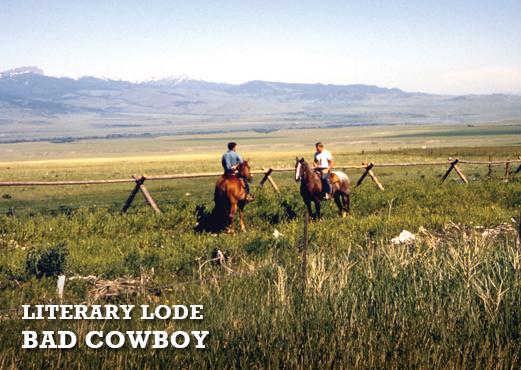Bad Cowboy

BAD COWBOY
by Landon Jones
Fifty years ago this year, I spent the best part of a summer wrecking ranch equipment. That was not my immediate purpose, but it could have been predicted. I had been hired to work as a hand on a cattle ranch outside of Ennis owned by my college roommate’s uncle, even though I had never worked on a ranch, ridden a horse, driven a tractor, or even been to Montana.
I was a poor risk. The ranch was nestled up against the mountains on the east side of the Madison Valley. If you stood up from the seat of your tractor, you could look out at an uninterrupted expanse of ranchland stretching 50 miles north and south and 10 miles across to Ennis and Virginia City on the west side.
This ranch was home to 100 steers, 500 cow-calf pairs, a dozen hired hands, and four incompetent college students — soon to be labeled as “the College Cowboys.” Our main job was to make sure the livestock had plenty of hay for the winter. A lanky and dour-faced field hand, with the inevitable name of Bill, was in charge of this process — and therefore the four of us.
Bill would begin our day by driving a tractor-mower into the fields, all whirling and flashing blades. It would cut the hay and leave it in lines of parallel rows as neatly spaced as if an architect had drawn them there. Next, another ranch hand would drive a hay baler into the field, scooping up the windrows and binding and regurgitating the hay into rectangular bales left scattered throughout the field like so many children’s blocks.
Our job was to assemble the hay bales into enormous square stacks, each as big as a house. This was before the arrival of the machine-made round bales so characteristic of the West today, so you either stacked the 80-pound bales by hand or, better, you used a Farmhand tractor equipped with a 10-pronged forklift. If done gently and delicately, as a weight-lifter might arrange sugar cubes into a neat pile, it was an art form.
We did not choose that option. Instead, we climbed into tractors with wheels higher than our heads, revved up the engine, and drove straight at the hay bales at full speed, with the forklift’s steel teeth protruding like spears in front of us. At a distance, we would have looked like deranged Don Quixotes, charging not at windmills but at hay bales.
If we did it right, it worked; we scooped and gathered the bales in groups of 12 and delivered them to a stack, where our waiting companions would arrange them in an intricate jig-saw pattern to prevent them from toppling over. But more of the time we would careen at the bales, with the forklift aimed too high. Its steel teeth would impale the bale athwart, in its mid-section, exploding it into a shower of hay and broken twine.
Even worse, if we aimed too low, the steel teeth would gouge into the dirt and then snap off with a sickening crack. The ranch had a fulltime employee whose job it was to hand-weld new teeth into the forklifts. The teeth cost about $80 each. My guess is that the cost of our damage exceeded our salaries for the entire summer.
One of our jobs involved watering the pasture with the method known as “flood irrigation” that has been used as long as humans have raised crops. We would open the head gate on an irrigation ditch and, once the water flowed into it, we would block it off with a portable canvas dam. The water would surge out across the field until it was thoroughly soaked.
The responsibilities of the College Cowboys also included shoveling out the calving shed, where the accumulated manure, piled up to a depth of four feet, gave pungent meaning to the phrase shoveling the Augean stable.
This month, 50 years later, I revisited the ranch. It looks the same, but it is no longer the same place. What I found was a lesson in technology and work patterns. The ranch in 1965 supported a community of more than a dozen adults who worked and lived there (in addition to the four College Cowboys). Today a single ranchhand does most of the work formerly shouldered by the entire group. A foreman cutting hay can sit in an air-conditioned cab and watch a movie on a DVR while a GPS system actually guides the tractor through its paces.
Field hands no longer slosh around in muddy fields doing flood irrigation, either. Instead, the hay fields are watered by enormous irrigation pivots — the long, connected arrays of pipes and sprinklers that look like the bones of a prehistoric reptile. The green circles of 140 to 160 acres they leave on the landscape are familiar sights to airline passengers. Yet environmentalists often point out that the pivot irrigators are inefficient: they lose more water to evaporation than does flood irrigation and do not allow the groundwater table to fully replenish itself.
What was my takeaway lesson from my visit a half-century later? A modern rancher would make the case that computer technology has enabled individual ranchers to survive at a time when agri-business giants dominate the West. They can keep their payrolls low and their costs competitive. But something is lost in this process, too. A community disappears — and takes with it the opportunity to educate the College Cowboys.
[This excerpt was originally printed in The Wall Street Journal.]
Leave a Comment Here
Leave a Comment Here